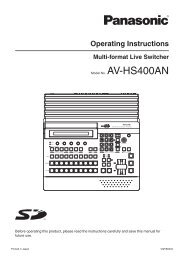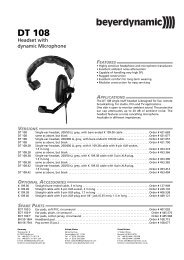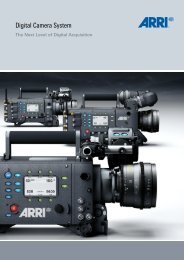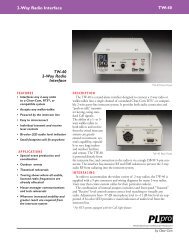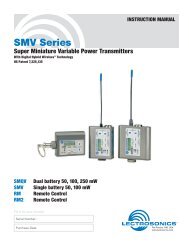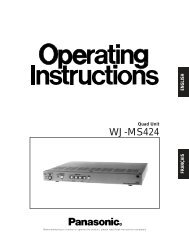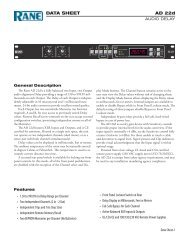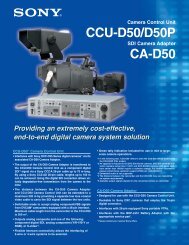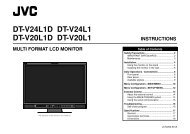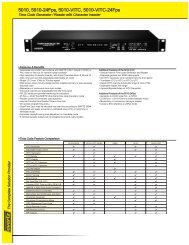Clear Com CS-222 Two Channel Main Station user manual - Talamas
Clear Com CS-222 Two Channel Main Station user manual - Talamas
Clear Com CS-222 Two Channel Main Station user manual - Talamas
You also want an ePaper? Increase the reach of your titles
YUMPU automatically turns print PDFs into web optimized ePapers that Google loves.
DESCRIPTION / <strong>Clear</strong>-Corn <strong>CS</strong>-<strong>222</strong> 2-<strong>Channel</strong> <strong>Main</strong> <strong>Station</strong><br />
O SECTION 1<br />
DESCRIPTION OF THE <strong>CS</strong>-<strong>222</strong> 2-CHANNEL INTERCOM STATION<br />
CLEAR-COM CONCEPT<br />
<strong>Clear</strong>-<strong>Com</strong> is a closed-circuit intercom system that consistently provides high-clarity<br />
communication in high-noise and low-noise environments. A basic system consists of a<br />
single- or multi-channel power supply or main station connected to various single- or<br />
multi-channel remote stations, such as beltpacks and loudspeaker stations.<br />
<strong>Clear</strong>-<strong>Com</strong> manufactures a wide variety of both portable and fixed-installation units. All<br />
are compatible with each other. <strong>Clear</strong>-<strong>Com</strong> intercom systems can also interface with<br />
other communication systems and devices.<br />
<strong>Clear</strong>-<strong>Com</strong> stations are interconnected with two-conductor, shielded microphone cable,<br />
using 3-pin XLR connectors. One wire carries the DC power (28-30 volts) from a main<br />
station or power supply to all remote stations, and the other wire carries 2-way (duplex)<br />
audio information. The shield acts as a common ground. One termination (per channel)<br />
Is needed throughout the intercom network, and is usually located in the main station or<br />
power supply.<br />
<strong>Clear</strong>-<strong>Com</strong> is a distributed amplifier system; each main and remote station houses its<br />
own mic preamplifier, headset or speaker power amplifier, and signaling circuitry. The<br />
Automatic Headset Detection circuit shuts off a station's mic pre-amp when the headset<br />
is disconnected, so background noise on the line is not increased by an unused yet online<br />
station. Low-impedance mic input lines (200 Ohms) and specially designed circuitry<br />
make <strong>Clear</strong>-<strong>Com</strong> channels virtually immune to RFI and dimmer noise.<br />
<strong>Clear</strong>-<strong>Com</strong> main stations, power supplies and certain remote stations each have an<br />
auxiliary program input with its own volume control, which allows an external audio<br />
source to be fed to the intercom system.<br />
Visual Signal Circuitry (CALL Lights), a standard feature on most main and remote<br />
stations, allows the <strong>user</strong> to attract the attention of operators who have removed their<br />
headsets.<br />
Depending upon the type of main and remote stations selected and assuming that<br />
enough DC power is available, a maximum number of remote stations from 10 (all<br />
speaker stations) to 30 (all headset stations) can be distributed along a mile of wire.<br />
Remote stations bridge the intercom line at a very high impedance (>10 KOhms), and<br />
place a minimum load on the line. The audio level always remains constant, and does<br />
not fluctuate as stations leave and join the network.<br />
0<br />
The 28-30 volts DC provided by main stations and power supply units enable remote<br />
stations to operate with minimal current (25 mA. quiescent for headset stations, 50 mA.<br />
quiescent for speaker stations) while generating extremely loud listen volumes (greater<br />
than 110dB SPL using <strong>Clear</strong>-<strong>Com</strong> Headsets). The highervoltageand lowcurrent keep<br />
voltage losses to an absolute minimum in long lines. If the supply voltage drops due to<br />
the addition of great length of cable or many more stations, <strong>Clear</strong>-<strong>Com</strong> equipment will<br />
continue operating with less than 12 volts available.<br />
2/92 Rev. 1.1 Page 4



